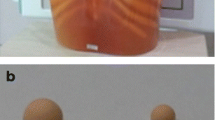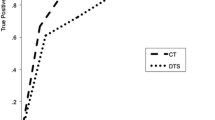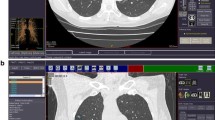Abstract
Purpose
We have been developing a computer-aided detection (CAD) system for lung nodules on multidetector row computed tomography (MDCT). The scheme for nodule detection in this system is featured by three-dimensional analysis for nodule detection in nodules and their surroundings, which is designed to discriminate nodules from blood vessels. The purpose of this study was to evaluate the CAD system.
Materials and methods
MDCT images from 30 patients with lung nodules were read twice, 3 weeks apart by a chest radiologist to detect noncalcified nodules of ≥4 mm. The first reading was without CAD, and the second reading was with CAD. Based on the reference standard later determined by another chest radiologist, the sensitivity of the former chest radiologist without or with CAD was obtained; the sensitivity and false-positive rate of the system alone were also obtained.
Results
The reference standard consisted of 66 nodules. The sensitivity of the chest radiologist was 77% (51/66) without CAD and 91% (60/66) with CAD, showing a significant improvement. The CAD system alone showed a sensitivity of 79% (52/66) with the false-positive rate of 4.5 per patient.
Conclusion
Although preliminary, these results indicate the efficacy of the CAD system.
Similar content being viewed by others
References
Li Q. Recent progress in computer-aided diagnosis of lung nodules on thin-section CT. Comput Med Imaging Graph 2007;31:248–257.
Brown MS, Goldin JG, Suh RD, McNitt-Gray MF, Sayre JW, Aberle DR. Lung micronodules: automated method for detection at thin-section CT—initial experience. Radiology 2003;226:256–262.
Suzuki K, Armato SG III, Li F, Sone S, Doi K. Massive training artificial neural network (MTANN) for reduction of false positives in computerized detection of lung nodules in low-dose computed tomography. Med Phys 2003;30:1602–1617.
Rubin GD, Lyo JK, Paik DS, Sherbondy AJ, Chow LC, Leung AN, et al. Pulmonary nodules on multi-detector row CT scans: performance comparison of radiologists and computer-aided detection. Radiology 2005;234:274–283.
Yuan R, Vos PM, Cooperberg PL. Computer-aided detection in screening CT for pulmonary nodules. AJR Am J Roentgenol 2006;186:1280–1287.
Austin JH, Müller NL, Friedman PJ, Hansell DM, Naidich DP, Remy-Jardin M, et al. Glossary of terms for CT of the lungs: recommendations of the Nomenclature Committee of the Fleischner Society. Radiology 1996;200:327–331.
McInerney T, Terzopoulos D. Deformable models in medical image analysis: a survey. Med Image Anal 1996;1:91–108.
Matsumoto S, Ohno Y, Yamagata H, Asahina H, Komatsu K, Sugimura K. Diminution index: a novel 3D feature for pulmonary nodule detection. In: Proceedings of computer assisted radiology and surgery CARS 2005. Amsterdam: Elsevier; 2005. p. 1093–1098.
Henschke CI, Yankelevitz DF, Mirtcheva R, McGuinness G, McCauley D, Miettinen OS. CT screening for lung cancer: frequency and significance of part-solid and nonsolid nodules. AJR Am J Roentgenol 2002;178:1053–1057.
Swensen SJ, Morin RL, Aughenbaugh GL, Leimer DW. CT reconstruction algorithm selection in the evaluation of solitary pulmonary nodules. J Comput Assist Tomogr 1995;19:932–935.
Hu S, Hoffman EA, Reinhardt JM. Automatic lung segmentation for accurate quantitation of volumetric X-ray CT images. IEEE Trans Med Imaging 2001;20:490–498.
Matsumoto S, Ohno Y, Yamagata H, Asahina H, Sugimura K. A new scheme for computer-aided detection of CT lung nodules designed in consideration of ground-glass opacity. Int J Comput Assist Radiol Surg 2006;1:S352–S354.
Staib LH, Duncan JS. Model-based deformable surface finding for medical images. IEEE Trans Med Imaging 1996; 15:720–731.
Reeves AP, Kostis WJ. Computer-aided diagnosis of small pulmonary nodules. Semin Ultrasound CT MR 2000;21:116–128.
Giger M, Bae KT, MacMahon H. Computerized detection of pulmonary nodules in computed tomography images. Invest Radiol 1994;29:459–465.
Ko JP, Betke M. Chest CT: automated nodule detection and assessment over time—preliminary experience. Radiology 2001;218:267–273.
Armato SG III, Giger ML, MacMahon H. Automated detection of lung nodules in CT scans: preliminary results. Med Phys 2001;28:1552–1561.
Kanazawa K, Kawata Y, Niki N, Satoh H, Ohmatsu H, Kakinuma R, et al. Computer-aided diagnosis for pulmonary nodules based on helical CT images. Comput Med Imaging Graph 1998;22:157–167.
Gurcan MN, Sahiner B, Petrick N, Chan HP, Kazerooni EA, Cascade PN, et al. Lung nodule detection on thoracic computed tomography images: preliminary evaluation of a computer-aided diagnosis system. Med Phys 2002;29:2552–2558.
Lee JW, Goo JM, Lee HJ, Kim JH, Kim S, Kim YT. The potential contribution of a computer-aided detection system for lung nodule detection in multidetector row computed tomography. Invest Radiol 2004;39:649–655.
Bae KT, Kim JS, Na YH, Kim KG, Kim JH. Pulmonary nodules: automated detection on CT images with morphologic matching algorithm—preliminary results. Radiology 2005;236:286–294.
Qian J, Fan L, Wei G, Novak CL, Odry B, Shen H, et al. Knowledge-based automatic detection of multi-type lung nodules from multi-detector CT studies. SPIE 2002;4684: 689–697.
Ge Z, Sahiner B, Chan HP, Hadjiiski LM, Cascade PN, Bogot N, et al. Computer-aided detection of lung nodules: falsepositive reduction using a 3D gradient field method and 3D ellipsoid fitting. Med Phys 2005;32:2443–2454.
Boroczky L, Zhao L, Lee KP. Feature subset selection for improving the performance of false positive reduction in lung nodule CAD. IEEE Trans Info Tech Biomed 2006;30:504–511.
Author information
Authors and Affiliations
Corresponding author
Additional information
An erratum to this article is available at http://dx.doi.org/10.1007/s11604-009-0318-3.
About this article
Cite this article
Matsumoto, S., Ohno, Y., Yamagata, H. et al. Computer-aided detection of lung nodules on multidetector row computed tomography using three-dimensional analysis of nodule candidates and their surroundings. Radiat Med 26, 562–569 (2008). https://doi.org/10.1007/s11604-008-0272-5
Received:
Accepted:
Published:
Issue Date:
DOI: https://doi.org/10.1007/s11604-008-0272-5




